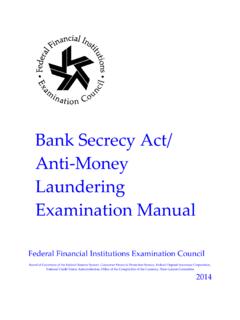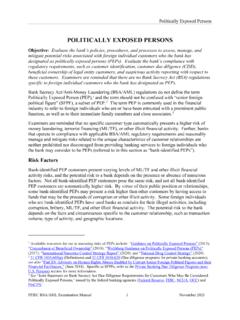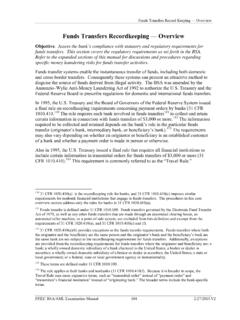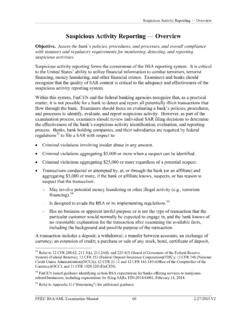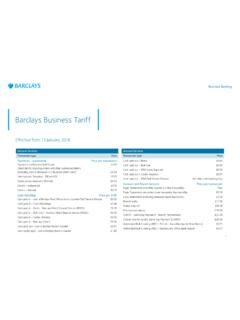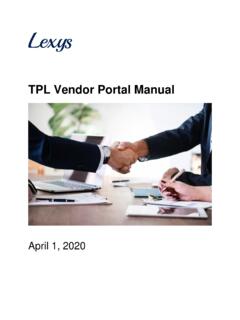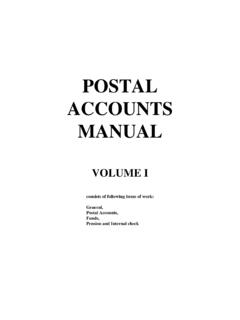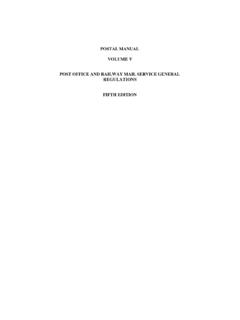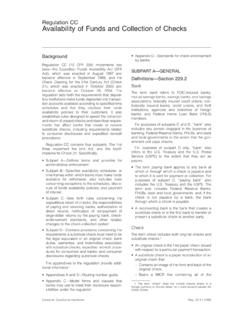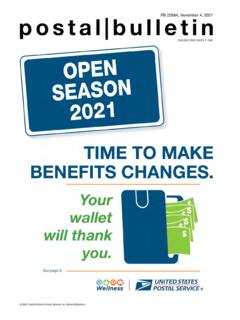Transcription of Overview - Federal Financial Institutions Examination Council
1 Nonbank Financial Institutions Overview FFIEC BSA/AML Examination manual 299 2/27 Nonbank Financial Institutions Overview Objective. Assess the adequacy of the bank s systems to manage the risks associated with accounts of nonbank Financial Institutions (NBFI), and management s ability to implement effective monitoring and reporting systems. NBFIs are broadly defined as Institutions other than banks that offer Financial services. The USA PATRIOT Act has defined a variety of entities as Financial Common examples of NBFIs include, but are not limited to: Casinos and card clubs. Securities and commodities firms ( , brokers/dealers, investment advisers, mutualfunds, hedge funds, or commodity traders).
2 Money services businesses (MSB).278 Insurance companies. Loan or finance Operators of credit card systems. Other Financial Institutions ( , dealers in precious metals, stones, or jewels;pawnbrokers).Some NBFIs are currently required to develop an AML program, comply with the reporting and recordkeeping requirements of the BSA, and report suspicious activity, as are NBFIs typically need access to banking services in order to operate. Although NBFIs maintain operating accounts at banks, the BSA does not require, and neither FinCEN nor the Federal banking agencies expect, banks to serve as the de facto regulator of any NBFI industry or individual NBFI customer.
3 Furthermore, while banks are expected to manage risk associated with all accounts, including NBFI accounts, banks are not held responsible for their customers compliance with the BSA and other applicable Federal and state laws and regulations. 277 Refer to Appendix D ( Statutory Definition of Financial Institution ) for guidance. 278 MSBs include five distinct types of Financial services providers and the postal Service: (1) dealers in foreign exchange ; (2) check cashers; (3) issuers or sellers of traveler s checks or money orders, ; (4) providers or se llers of prepaid access; and (5) money transmitters.
4 FinCEN routinely publishes administrative letter rulings that address inquiries regarding whether persons who engage in certain specific business activities are MSBs. 279 77 Fed. Reg. 8148 (February 14, 2012) defines non-bank residential mortgage lenders and originators as loan or finance companies for the purpose of requiring them to establish anti-money laundering programs and report suspicious activity. FinCEN Guidance FIN-2012-R005, Compliance obligations of certain loan or finance company subsidiaries of Federally regulated banks and other Financial Institutions (August 13, 2012), confirms that when a subsidiary loan or finance company is obligated to comply with the AML and SAR regulations that are applicable to its parent Financial institution and is subject to Examination by the parent Financial institution s Federal functional regulator, the loan or finance company is deemed to comply with FinCEN s regulation.
5 280 Refer to 31 CFR Chapter X for specific regulatory requirements. Nonbank Financial Institutions Overview FFIEC BSA/AML Examination manual 300 2/27 Risk Factors NBFI industries are extremely diverse, ranging from large multi-national corporations to small, independent businesses that offer Financial services only as an ancillary component to their primary business ( , grocery store that offers check cashing). The range of products and services offered, and the customer bases served by NBFIs, are equally diverse. As a result of this diversity, some NBFIs may be lower risk and some may be higher risk for money laundering.
6 Banks that maintain account relationships with NBFIs may be exposed to a higher risk for potential money laundering activities because many NBFIs: Lack ongoing customer relationships and require minimal or no identification fromcustomers. Maintain limited or inconsistent record keeping on customers and transactions. Engage in frequent currency transactions. Are subject to varying levels of regulatory requirements and oversight. Can quickly change their product mix or location and quickly enter or exit an operation. Sometimes operate without proper registration or Mitigation Banks that maintain account relationships with NBFIs should develop policies, procedures, and processes to: Identify NBFI relationships.
7 Assess the potential risks posed by the NBFI relationships. Conduct adequate and ongoing due diligence on the NBFI relationships when necessary. Ensure NBFI relationships are appropriately considered within the bank s suspiciousactivity monitoring and reporting Assessment Factors Banks should assess the risks posed by their NBFI customers and direct their resources most appropriately to those accounts that pose a more significant money laundering risk. The following factors may be used to help identify the relative risks within the NBFI portfolio. Nevertheless, management should weigh and evaluate each risk assessment factor to arrive at a risk determination for each customer and to prioritize oversight resources.
8 Relevant risk factors include: Types of products and services offered by the NBFI. Locations and markets served by the Financial Institutions Overview FFIEC BSA/AML Examination manual 301 2/27 Anticipated account activity. Purpose of the bank s due diligence should be commensurate with the level of risk of the NBFI customer identified through its risk assessment. If a bank s risk assessment indicates potential for a heightened risk of money laundering or terrorist financing, the bank is expected to conduct further due diligence in a manner commensurate with the heightened risk.
9 Providing Banking Services to Money Services Businesses FinCEN and the Federal banking agencies issued interpretive guidance on April 26, 2005, to clarify the BSA requirements and supervisory expectations as applied to accounts opened or maintained for With limited exceptions, many MSBs are subject to the full range of BSA regulatory requirements, including the anti-money laundering program rule, suspicious activity and currency transaction reporting rules, and various other identification and recordkeeping Existing FinCEN regulations require certain MSBs to register with Finally, many states have established supervisory requirements, often including the requirement that an MSB be licensed with the state(s) in which it is incorporated or does business.
10 FinCEN defines MSBs as doing business in one or more of the following capacities: Dealer in foreign exchange Check casher Issuer or seller of traveler s checks or money orders Money transmitter Provider of prepaid access281 Refer to Interagency Interpretive Guidance on Providing Banking Services to Money Services Businesses Operating in the United States, April 26, 2005. 282 Refer to 31 CFR (requirement for MSBs to establish and maintain an anti-money laundering program); 31 CFR (requirement for MSBs to file Currency Transaction Reports); 31 CFR (requirement for MSBs to file Suspicious Activity Reports, other than for check cashing); 31 CFR (requirement for MSBs that sell monetary instruments for currency to verify the identity of the customer and create and maintain a record of each currency purchase between $3,000 and $10,000, inclusive); 31 CFR (e) and (f) (rules applicable to certain transmittals of funds).
